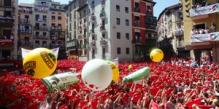Spidercam gives bird's-eye view
The newest innovation in broadcasting at the World Cup has a super hero-sounding name and gives the armchair fan a bird's-eye, 3-D view of the action.
It can swing from a thread. Take a look overhead ... It's called the Spidercam.
The tension cable-harnessed camera dubbed the "Spidercam" is making its World Cup debut, suspended 20 meters above the pitch and capable of being pulled back and forth to provide live, overhead images at four of the 10 tournament venues in South Africa.
"The perspective is unusual, because the other cameras are outside the field," said Felix Werremeier, who pilots the 22-kilogram cable-mounted device, which uses 3D motion software.
"The main thing we must convey is a (sense) of motion and the dynamic of the players."
This year, World Cup coverage uses a standard 30 cameras for each match, four more than during the 2006 tournament in Germany, and including two ultra-motion cameras that can record up to 1,000 frames per second to dramatically slow down the action for replays.
Twin-lens 3D cameras are also at every game, along with "steadicams," which are harnessed to the bodies of film crew members, and crane-operated cameras at pitch-level.
Important matches get two additional cameras: one mounted on a helicopter and a Spidercam. From the quarterfinals on, coverage of every match will include a Spidercam.
Oddly, though, the referees don't get to use any of the technology to help adjudicate on line-ball decisions- unlike in sports such as tennis, cricket and rugby. That's something FIFA, football's world governing body, is promising to again reconsider in the wake of glaring errors that hurt England and Mexico in their second-round exits.
On a rainy recent afternoon, Werremeier sat under a tiny tarpaulin-covered control booth set up on the side of the pitch checking the joysticks, monitors and wiring needed to move his camera over Durban's Moses Mabhida stadium.
Key to the system are four motorised winches which either wind up or slacken rope carrying fiberoptic cable to the Spidercam, for relaying commands and receiving the picture signal.
The winches on the ground can each roll up to 300 meters of taught rope, moving the camera via four pulleys mounted to the supports originally set up for stadium lighting.
"During matches, I look at the monitor mostly, but you also have to look out onto the pitch and see where the camera is," said Werremeier, who works for Professional Motion Technology, German firm that operates the Spidercam.
The Spidercam has already been used for broadcasts of Champions League matches and for other sporting invents including international swimming, rugby and tennis and the track and field 2009 world championships in Berlin.
The technology is not restricted to sports, with Spidercam used in the coverage of Robbie Williams, Kylie Minogue, The Police and U2 concerts around the world, as well as the Eurovision song contest among others.
"There's a big difference between a soccer field, being outside, and a small studio with a very small field of flight and requiring very precise movement," Werremeier said.
The operators aren't concerned about a few stray kicks, either.
"We are always near the action but we try to always know what is going on," Werremeier said. "And of course, we are always at least 20 meters (yards) above the field to be quite safe from the ball."
 © 2025 AAP
© 2025 AAP















Post a comment about this article
Please sign in to leave a comment.
Becoming a member is free and easy, sign up here.